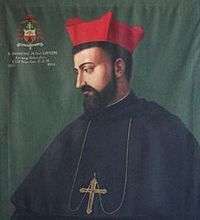Dionisio Laurerio
Dionisio Laurerio (1497–1542) (also known as fra Dionisio di Benevento and as the Cardinal of San Marcello) was an Italian Roman Catholic cleric who was the superior general of the Servite Order from 1535 to 1542, a cardinal from 1539, and a bishop from 1540.


Biography
Early years, 1497–1535
Dionisio Laurerio was born in Benevento in 1497.[1] He was from a little-known family with links to the Pedicini family, a local patrician family.[1] Both of his parents were originally from Florence.[1]
He entered the Servite Order at a young age and was educated by his order.[1] He obtained a doctorate in 1521.[1] After he was ordained as a priest, he became a lector of philosophy, metaphysics, mathematics, and theology at the University of Perugia and the University of Bologna from 1526 to 1529, then at the Sapienza University of Rome.[1]
At a chapter of the Servite Order held in Cesena on 18 May 1528, he was elected procurator of the order.[1]
In 1534, Henry VIII of England made Laurerio his minister to Pope Clement VII, replacing Thomas Cranmer.[1] Laurerio traveled to London to deal with urgent religious matters in the Kingdom of England.[1]
At that time, he developed a friendship with Cardinal Alessandro Farnese, the future Pope Paul III, who he probably already knew from Benevento, and who made Laurerio his theologian in sacris.[1] Laurerio also developed friendships with humanist Jacopo Sannazzaro and Cardinals Reginald Pole and Jacopo Sadoleto.[1]
Early years as Superior General of the Servite Order, 1535–39
Pope Paul III made Laurerio vicar general of the Servite Order on 22 January 1535.[1] On 27 April 1535, at a chapter celebrated in Bologna, the Servite Order elected him to be its superior general.[1] He resigned this post in May 1542.[1] While he was superior general, the pope gave him the ability to found, visit, and reform any monasteries of his order.[1]
On 23 October 1536 the pope named him his nuncio to James V of Scotland, tasking him with reporting on the desirability of holding an ecumenical council, and also giving him the powers of a legate a latere to visit and reform institutions in the Kingdom of Scotland to prevent them from joining Henry VIII of England in breaking with Rome.[1] Laurerio met James in Paris on 27 January 1537 and probably never actually visited Scotland.[1] He convinced the king to support an ecumenical council but was unable to convince the cloistered of the Kingdom of France to agree.[1]
In autumn 1537 he was back in Rome where he participated in discussions on reforming the Apostolic Dataria.[1]
Cardinal, 1539–42
Pope Paul III made him a cardinal priest in the consistory of 19 December 1539.[1] He received the red hat on 22 December 1539, and the titular church of San Marcello al Corso on 28 January 1540.[1]
On 13 February 1540 he was elected Bishop of Urbino.[1] He took possession of the see on 3 March 1540.[1] In early August 1540 he accompanied the pope to Lucca to meet Charles V, Holy Roman Emperor to discuss convening an ecumenical council in Vicenza.[1]
In poor health, he then went to rest in convents in Pistoia, Prato, and then Florence for a few months.[1] He also acted as nuncio to Cosimo de' Medici during this period.[1] He also played a crucial role in restoring the baths of Bagni San Filippo.[1] He also stopped in Urbino to begin the canonization process for the Servite Girolamo Ranuzzi, installing his relics in that city.[1] On 27 August 1540 the pope tasked him and Cardinals Gasparo Contarini and Gian Pietro Carafa with studying proposals to reform the Apostolic Penitentiary; this commission met sporadically.[1]
In spring 1541, the pope despatched Cardinal Laurerio to Modena as pontifical inquisitor delegate for the process against writer Giovanni Bertario.[1] Bertario had been excommunicated in absentia; together with Cardinal Alessandro Farnese, Cardinal Laurerio had this sentence reduced, ordering Bertario to recant his allegedly heretical statements.[1]
In the consistory of 27 May 1541 Cardinal Gasparo Contarini presented a proposal for reconciliation with the Protestants, supported by Cardinal Alvise Priuli. Cardinal Laurerio vehemently opposed this proposal.[1]
Resigning as superior general of the Servite Order in May 1542, he convoked a general chapter of the order in spring 1542, which saw him replaced by Agostino Bonucci.[1]
When, on 21 July 1542, Pope Paul III issued the papal bull Licet ab initio reorganizing the Roman Inquisition, Laurerio was named one of the six cardinal inquisitors of the reformed Inquisition.[1]
On 11 August 1542 the pope named him papal legate in Benevento and provisor of the Campagne and Maritime Province.[1]
He died in Rome on 17 September 1542 after a brief illness.[1] He was buried in his titular church of San Marcello al Corso.[1]
References
| Wikimedia Commons has media related to Dionisio Laurerio. |